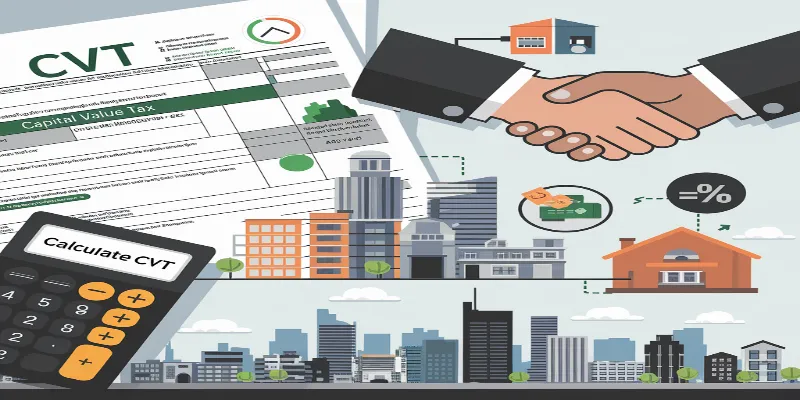
Capital Value Tax (CVT) is a 2% tax levied on the sale of immovable property in Pakistan. The tax is calculated based on the assessed value of the property, which is determined by a government valuation agency. This valuation considers various factors including the property's size, location, and other characteristics that influence its overall value. CVT isn't a new tax; it was first introduced in 1989 but was removed in 2020. It has now been brought back with the Finance Act of 2022. In this article, we'll explain the Capital Value Tax for 2024 in Pakistan, who needs to pay it, and how it affects taxpayers.
Table Of Content
- What Is Capital Value Tax?
- Applicability Of Capital Value Tax
- Implications Of Capital Value Tax For Taxpayers
- Conclusion
What Is Capital Value Tax?
Capital Value Tax (CVT) is a tax levied on the value of high-value assets, including both movable and immovable properties. Its primary goal is to generate revenue from wealth held in capital assets, which often appreciate over time. CVT is imposed at 2% of the gross value of assets, such as properties and vehicles, above certain thresholds. This tax applies mainly to resident individuals, with non-residents typically exempt from its provisions.
Applicability Of Capital Value Tax

CVT applies to both movable and immovable assets held within Pakistan, as well as foreign assets and certain motor vehicles. Its reintroduction has caused ripples among asset owners, particularly those dealing with high-value properties, as it directly affects the overall cost of owning or transferring these assets.
Here’s a breakdown of the key categories where Capital Value Tax is applicable:
1. CVT on Immovable Properties
One of the main targets of CVT is immovable properties (real estate) such as houses, apartments, plots of land, and commercial buildings. The tax is levied at 1% of the property’s gross value, provided the value exceeds PKR 100 million.
For instance, if a property is worth PKR 120 million, the tax levied would be:
CVT = 1% of PKR 120,000,000 = PKR 1,200,000
The tax is payable at the time of the sale, purchase, or transfer of the property and must be filed with the income tax return for the relevant year.
2. CVT on Movable Properties
CVT also applies to movable properties, which typically include financial assets like stocks, bonds, and other securities. Similar to immovable properties, CVT is charged at 1% of the gross value of these assets if the total value exceeds PKR 100 million.
Whether it’s transferring a large portfolio of securities or liquidating shares, taxpayers need to be mindful of this additional 1% tax. The tax is calculated at the time of the asset transfer and is payable along with other tax liabilities during the annual income tax filing.
3. CVT on Foreign Assets
In a globalized world, many Pakistani residents hold assets abroad. From real estate to financial investments in foreign markets, these assets are now subject to CVT. The same 1% rate applies to foreign assets that exceed PKR 100 million in value.
This inclusion aims to broaden the tax net, capturing wealth that may have previously escaped domestic taxation. It is important for taxpayers with overseas holdings to carefully track and report the value of their foreign assets to avoid non-compliance.
4. CVT on Motor Vehicles
CVT also applies to motor vehicles, specifically those with an engine capacity of 1300cc or above, or electric vehicles with a power output of 50 kWh or more. As with other categories, the tax rate is 1% of the vehicle’s invoice value.
The tax is collected at the time of purchase by the seller in case of locally manufactured vehicles. For imported vehicles, the tax is collected by customs authorities at the time of importation. For instance, if an individual imports a high-end luxury vehicle valued at PKR 15 million, the CVT would be:
Implications Of Capital Value Tax For Taxpayers

The reintroduction of Capital Value Tax in Pakistan has several key implications for taxpayers:
- Increased Cost of Asset Transactions: For individuals dealing with high-value properties, securities, or vehicles, the 1% tax adds a significant cost to buying or selling these assets. This could influence decisions related to asset transfers or investments.
- Broader Tax Compliance: Taxpayers must now be more diligent in tracking both their domestic and foreign assets. Accurate reporting is critical, as failure to pay CVT can lead to penalties or legal action.
- Impact on the Wealthy: Given that the tax primarily targets high-value assets, its reintroduction signals the government’s intention to increase the tax burden on wealthier individuals, making them contribute more to public revenue.
- Administrative Hurdles: For those with large portfolios of assets, especially those held overseas, complying with CVT can introduce additional administrative complexities. Maintaining up-to-date valuations and records is essential to avoid complications.
Conclusion
The Capital Value Tax (CVT) in Pakistan is a tax designed to capture wealth from high-value assets, particularly in real estate, securities, foreign assets, and luxury vehicles. Though it had been abolished, its reintroduction through the Finance Act of 2022 has brought it back into the spotlight. As we move into the tax year 2024, it is crucial for taxpayers to understand how CVT works, the assets it applies to, and the steps required to comply with this tax. For those with significant holdings in real estate or financial assets, paying attention to CVT is not only a legal requirement but a necessary part of financial planning. Being aware of its implications and staying compliant can help avoid potential legal issues while ensuring that high-value assets are managed effectively.


